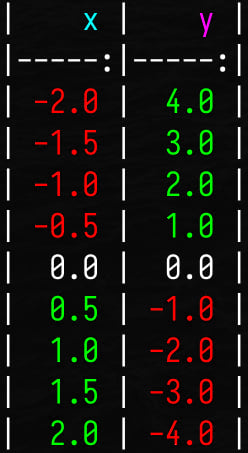21 releases
| 0.5.6 | Apr 16, 2025 |
|---|---|
| 0.5.5 | Feb 20, 2025 |
| 0.5.4 | Dec 4, 2024 |
| 0.5.3 | Oct 24, 2024 |
| 0.4.7 | Dec 18, 2023 |
#2 in #colored
189 downloads per month
Used in 4 crates
64KB
256 lines
Usage
-
Implement
Tabletrait for your custom type by defining therowmethod which returns the type as aVec<String>. -
Create a
Vegstruct with a header definition based on a Markdown table header. -
Use the
Vegstruct like aVecto gather instances of your type. -
Call one of the following methods to generate a table:
markdown: Markdown table using the initial header definitionmarkdown_with: Markdown table using a custom header definition and/or column indexes
Example
// Import Veg
# use anyhow::anyhow;
use veg::Veg;
// Create a custom type
struct Point {
x: f32,
y: f32,
}
// Implement a method that creates a Box of the custom type
impl Point {
fn new(x: f32, y: f32) -> Box<Point> {
Box::new(Point { x, y })
}
}
// Implement the veg::Table::row method to define how to print the custom type
impl veg::Table for Point {
fn row(&self) -> Vec<String> {
// Add `$` for inline LaTeX math spans
[self.x, self.y].iter().map(|x| format!("${x}$")).collect()
// Other ideas:
//
// - Add 3 decimal places:
//
// [self.x, self.y].iter().map(|x| format!("${x:.3}$")).collect()
//
// - Do something different for x and y:
//
// vec![
// format!("${:.1}$", self.x),
// format!("${:.4}$", self.y),
// ]
//
// - Just convert to string:
//
// [self.x, self.y].iter().map(|x| x.to_string())).collect()
//
// ...
}
}
// Create a Veg via the table method with a header definition
let mut v = Veg::table("$x$|$y$\n-:|-:");
// Add a single point
v.push(Point::new(1.0, 1.0));
// Add a bunch of points
v.append(&mut vec![
Point::new(2.0, 4.0),
Point::new(3.0, 9.0),
Point::new(4.0, 16.0),
]);
// Render as a markdown table
assert_eq!(
v.markdown().unwrap(),
"\
| $x$ | $y$ |
|----:|-----:|
| $1$ | $1$ |
| $2$ | $4$ |
| $3$ | $9$ |
| $4$ | $16$ |
\
",
);
// Render as a markdown table with a modified header definition
assert_eq!(
v.markdown_with(Some("X|Y\n-|-"), None).unwrap(),
"\
| X | Y |
|-----|------|
| $1$ | $1$ |
| $2$ | $4$ |
| $3$ | $9$ |
| $4$ | $16$ |
\
",
);
// Render as a markdown table with a modified header definition to increase the
// column widths
assert_eq!(
v.markdown_with(Some("X|Y\n------|------"), None).unwrap(),
"\
| X | Y |
|--------|--------|
| $1$ | $1$ |
| $2$ | $4$ |
| $3$ | $9$ |
| $4$ | $16$ |
\
",
);
// Just render the second column
assert_eq!(
v.markdown_with(None, Some(&[1])).unwrap(),
"\
| $y$ |
|-----:|
| $1$ |
| $4$ |
| $9$ |
| $16$ |
\
",
);
// Reorder the columns
assert_eq!(
v.markdown_with(None, Some(&[1, 0])).unwrap(),
"\
| $y$ | $x$ |
|-----:|----:|
| $1$ | $1$ |
| $4$ | $2$ |
| $9$ | $3$ |
| $16$ | $4$ |
\
",
);
// Duplicate column `y`
assert_eq!(
v.markdown_with(None, Some(&[0, 1, 1])).unwrap(),
"\
| $x$ | $y$ | $y$ |
|----:|-----:|-----:|
| $1$ | $1$ | $1$ |
| $2$ | $4$ | $4$ |
| $3$ | $9$ | $9$ |
| $4$ | $16$ | $16$ |
\
",
);
// Try to give invalid column indexes
assert_eq!(
v.markdown_with(None, Some(&[3, 2, 0, 1])).unwrap_err().to_string(),
"Invalid column indexes: 2, 3",
);
Features
colored
The colored feature enables the veg::colored module which provides the
same API, but uses the colored crate to colorize Veg tables for printing
to the terminal.
See tests/colored.rs and/or run
cargo test --features colored --test colored -- --nocapture.

Changelog
- 0.1.0 (2023-12-11): Initial release
- 0.1.1 (2023-12-11): Add makefile, changelog; fix readme, clippy
- 0.2.0 (2023-12-11): Convert the table function to a method
- 0.2.1 (2023-12-11): Fix readme
- 0.3.0 (2023-12-12): Enable single column tables; add the
markdown_withmethod to enable column subsets, reordering, duplicating, and temporary headers; add examples to the module doctest - 0.4.0 (2023-12-16): Add
coloredfeature/module enabling terminal colors via thecoloredcrate- 0.4.1 (2023-12-16): Fix changelog
- 0.4.2 (2023-12-17): Improve readme, doc, and tests
- 0.4.3 (2023-12-17): Add doc for colored module; make the colored png smaller; improve doc
- 0.4.4 (2023-12-17): Fix colored module doc
- 0.4.5 (2023-12-17): Fix doc
- 0.4.6 (2023-12-18): Fix veg::colored::Veg::table argument type
- 0.4.7 (2023-12-18): Add
Veg::is_emptymethods - 0.4.8 (2024-01-06): Fix empty string find unwrap issue; update dependencies
- 0.5.0 (2024-03-10): Fix Unicode text width algorithm; update dependencies
- 0.5.1 (2024-07-26): Fix makefile; update dependencies
- 0.5.2 (2024-10-18): Update dependencies
- 0.5.3 (2024-10-24): Update dependencies
- 0.5.4 (2024-12-04): Update dependencies; add commit target to makefile
- 0.5.5 (2025-02-20): Update dependencies
- 0.5.6 (2025-04-16): Update dependencies
Dependencies
~0.7–7MB
~45K SLoC